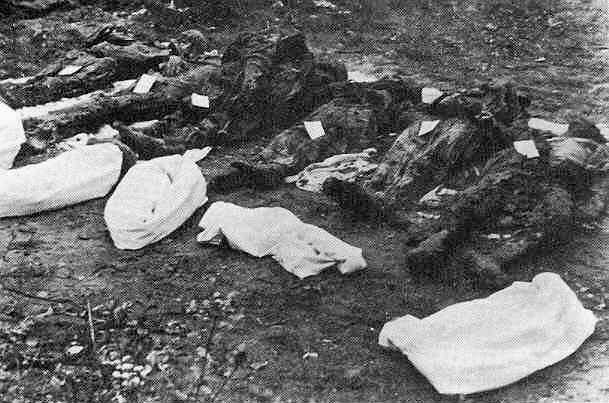 The six murdered American airmen are exhumed in Russelsheim, Germany. U.S.Army Signal Corps |
Rogers gathered all his evidence, and turned it over to the War Crimes Branch. Lt. Col. Leon Jaworski would present the case against the Russelsheim civilians. Finally the much wanted instigator, Josef Hartgen, was captured and rushed to Wiesbaden for interrogation. While in jail he attempted suicide by slashing his wrist on the mattress springs. He was rushed to the hospital, and after recovering was returned to jail.
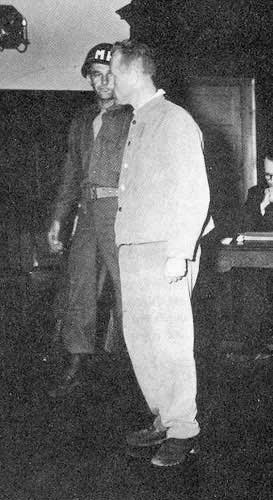 Josef Hartgen is found guilty and sentenced to death. U.S. Army Signal Corps |
Part of the Geneva Convention of 1929 states that "Prisoners must at all times be treated with humanity and protected particularly against acts of violence". Also, the Hague Convention stipulates that "In addition to the prohibitions provided by special conventions, it is expressly forbidden to kill or wound an enemy who, having laid down his arms, or having no longer any means of defense, has surrendered at discretion". It was specified that "German civilians are bound to observe the laws of war".As Loen Jaworski was the Trial Judge Advocate, the defense was led by Lt. Col. Roger E. Titus. He had the unenviable position of defending the enemy. A group of eleven of the accused, including Hartgen, were first on trial. All pleaded not guilty. Testimony against them was by 21 witnesses. The trial lasted six days, with eyewitness testimony to the cold-bloodied assassinations by Josef Hartgen, and chilling accounts of the bludgeoning of the airmen. They could not account for the two missing men, as everyone was certain there had been eight originally. As the trial proceeded Josef Hartgen was accused of extreme brutality, and vicious and unthinkable conduct in the execution of the defenseless airmen. Five of the group, including Hartgen, were found guilty and sentenced to death. The remainder were given varying prison terms.
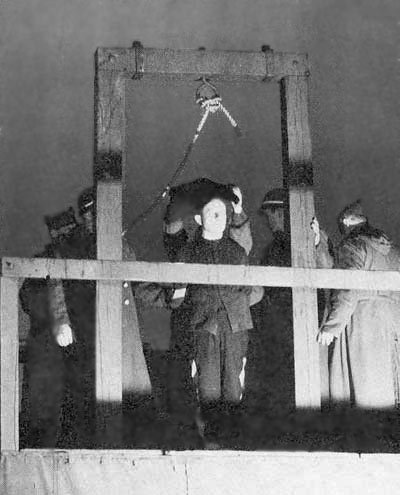 Josef Hartgen, who killed four of the B-24 crewmen, awaits his execution. National Archives |
The question lingered as to what happened to the two crewmembers, Sgt. William M. Adams, and Sgt. Sidney E. Brown. The crew originally consisted of nine, with S/Sgt. Brininstool wounded and sent to a German hospital, and six executed.
Three weeks after the trial General Davidson received a letter from Sgt. William M. Adams, and Sgt. Sidney Brown. Both had been returned to the U.S. The letter fully explained their experience during the "Death March", and their miraculous escape, only to be captured four days later. They offered to supply any information they had concerning the ordeal. They had survived the beatings. While the cart with the bodies was at the cemetery awaiting burial, Adams and Brown were able to crawl from under the bodies and escape. After their recapture they were sent to Stalag Luft IV, a POW camp for airmen. Both were liberated in May by the Ninth Army and the British Army. They Returned to the U.S. and gave the authorities what information they had. In the meantime Hartgen and four others were hung on Nov. 10. Otto Stolz was convicted of beating the airmen and helping Hartgen load the bodies in the cart, and accompanying the cart to the cemetery where he fatally beat some of the airmen who were still alive. He was sentenced to death and hanged. It must be noted that none of the women were executed even though they were the primary instigators who excited the crowd to riot and helped in the beatings. The bodies of Austin, Dumont, and Sekul were transferred to their respective hometowns, while the bodies of Rogers, Williams, and Tufenkjian are buried in France.
In August of 2001, the tail gunner, Sidney E. Brown of Florida was invited back to the town of Russelsheim to receive a formal apology.
Written by Norman J. Fairchild who gave written permission for it's use on this website.
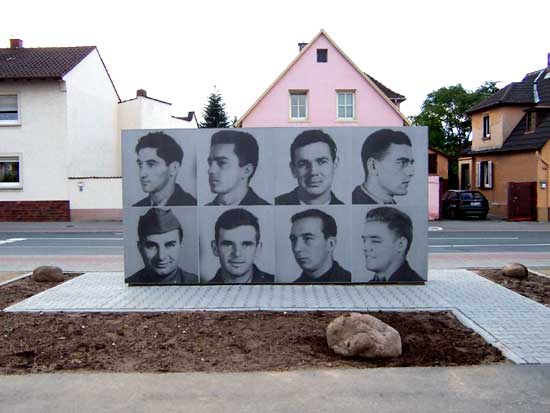
Pictured above: Permanent memorial dedicated to the Rogers' crew by citizens of Russelsheim.
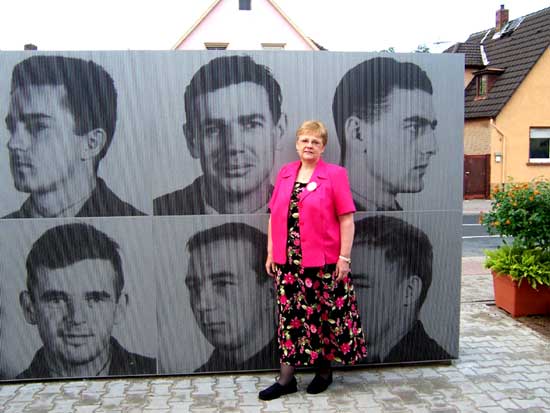
Pictured above: Madeline Teremy stands in front of Memorial which contains photos of the B-24 crew. Her father was the pilot, 2nd Lt. Norman J. Rogers Jr.
SOURCES:
National Archives, Suitland, Maryland
U.S. Army Signal Corps
Stars and Stripes
Transcript of Trial
Bomber Command reports
N.Y. Times
German Documentaries
Winston Ramsey's article on the "Death March".
Report on the "Death March" by Thomas Frickel
In the Russelsheim Echo